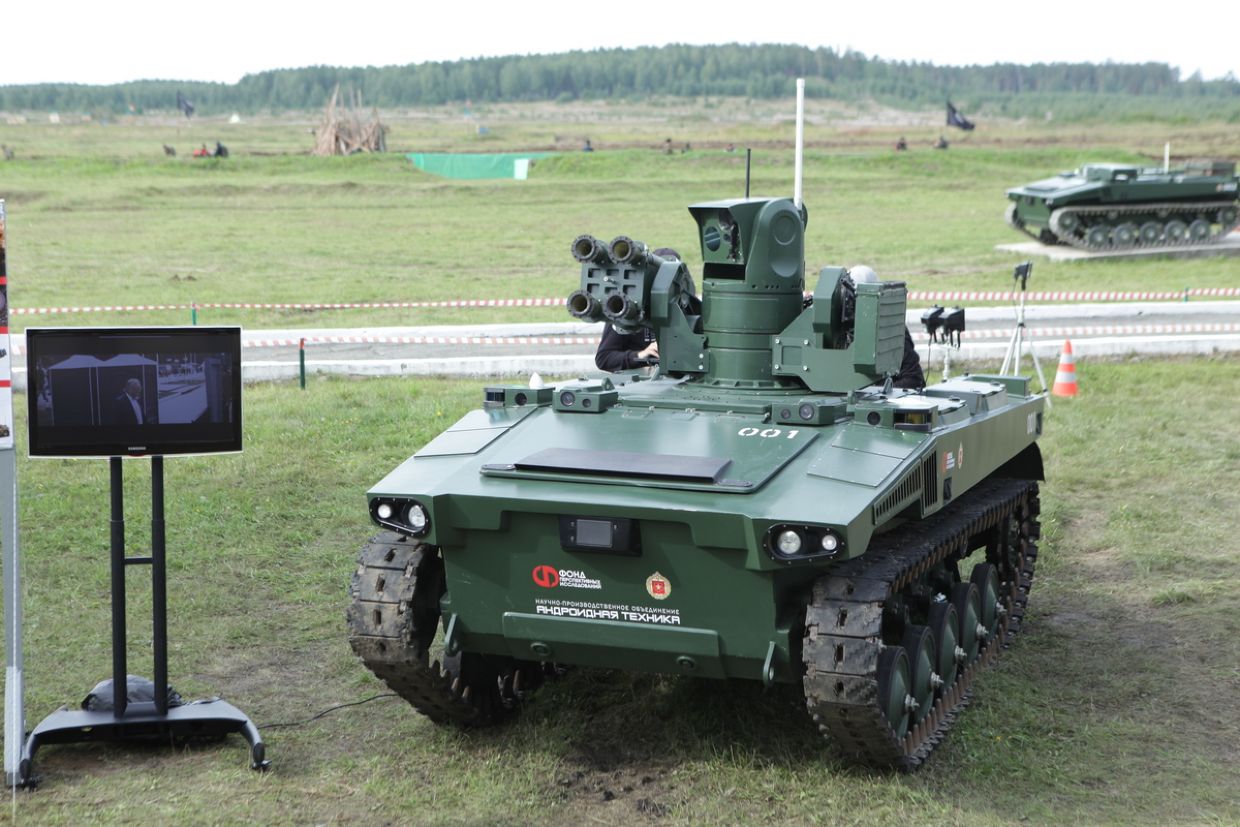Russian fighters have managed to assemble two makeshift armed unmanned ground vehicles (UGV) to take on Ukrainian infantry and hardened positions in the east. Videos on various Telegram groups show two crudely designed yet highly effective UGVs with heavy machine guns being tested.
Russia is making a last push to take the remaining areas from the breakaway pro-Russian Donbas from Ukraine and possibly declare an end to war before Western tanks hit the battlefield.
The intense fighting and heavy resistance by the Armed Forces of Ukraine (AFU) has raised the need for a large number of drones, both aerial and ground, to adapt to the new battlefield and tactical dynamics.
This is mainly to address the painstaking logistical challenges to supply the long-range gun and rocket artillery, where kamikaze drones (or loitering munitions), heavier and more explosive than the Lancet-3, are needed to pick apart Ukrainian artillery quickly.
UGVs immensely help in long-grinding infantry battles in both fields and built-up areas, as either side takes time to break the logjam and take heavy losses in the bargain. This was evident from the bloody urban, often house-to-house combat seen in Soledar and Bakhmut, where the PMC Wagner fighters were heavily involved.
Russia has already introduced its domestically developed Marker UGV, announced to be designed to take out US Abrams and German Leopard main battle tanks (MBT). The first batch reached the front earlier this month.

The former head of Russia’s space agency Roscosmos, Dmitry Rogozin, who has volunteered to fight in the Special Military Operation (SMO), had said they would undergo a “baptism by fire” by directly getting their first tank kills on the battlefield.
Russian Infantrymen Step To Make Their Own Robots
The two UGVs in the videos are claimed to be developed by Russian fighters engaged in Kupiansk in northeast Ukraine, in the Kharkiv Oblast. Around 50,000 soldiers are engaged in the offensive towards Kupiansk.
Called “self-propelled robotic combat modules,” the vehicles were reported to be undergoing “baptism of fire” near Svatov and are claimed to be “helping” Russian infantrymen.
Svatov (or Svatove in Russian), just on the border of the LPR and Kharkiv, saw heavy fighting by the second week of this month, where Russian forces claimed to have inflicted severe losses on the AFU at the Svatove-Kreminna axis.
Troops from the "V" group created a prototype of a combat robot on a wheeled chassis. This model is armed with a Kalashnikov Tank PKT machine gun, two RPG-7s, and two RPG-26s. The radius of the prototype is 1000 meters from the remote control. #UkraineRussianWar #UkraineWar pic.twitter.com/2MiKyMqH8S
— EurAsian Times (@THEEURASIATIMES) February 27, 2023
Makeshift Yet Effective Combat UGVs
The first UGV is an eight-wheeled machine with two trailers, one carrying a generator and the other a gun turret. The turret has two 7.62 mm PKT machine guns, while the generator “regulates” the barrels. This can mean the generator might be powering the turret, which raises the question of how the UGV might be powered for mobility.
This can be possible through independent motors on each of the trailer’s wheels carrying the generator, as seen in the video. Another likelihood is that the generator is powering both the motors for movement and the turret.
The UGV keeps moving up and down a short patch on a dirt road in a forest, and a soldier appears, holding a large console, fixing a minor glitch with the box magazine and belt feed.
Both the guns keep firing intermittently. This video is meant for demonstration purposes, as the guns are firing in random directions and angles, at one point even upwards at the trees.
The second UGV is claimed to be more “perfect and not so noisy” and is equipped with rechargeable batteries, “allowing it to sneak up to enemy firing lines undetected.” The generator is, however, still seen in the same arrangement in this second UGV, too, and is likely the primary mobility powerplant.
The batteries are probably meant to be activated when operating in stealth modes. This UGV’s rotatable swiveling turret carries a single NSVT 12.7 mm machine gun. The rounds are claimed to penetrate the side armor of most armored personnel carriers (APC) and infantry fighting vehicles (IFV).
The description on one of the posts on a Telegram group said the video feed from the cameras is sent to the operator’s console. However, no electro-optical system is seen on the UGVs. But their defining feature is an “explosive device” meant to blow up the machine and “prevent” it from falling into Ukrainian hands. The operator can trigger the bomb.
Both the UGVs seem a little more than functional. They can achieve fundamental tactical battlefield tasks, like laying down suppressing fire or charging into heavily defended areas, while friendly troops take complementing actions.
But the possible absence of an optical camera means the controller has been around and keeps the UGV in line of sight while also continuously observing its own troops. Neither is its range from the wireless control or endurance known, which could either not be very impressive or hidden for tactical purposes.
- The author can be reached at satamp@gmail.com
- Follow EurAsian Times on Google News




